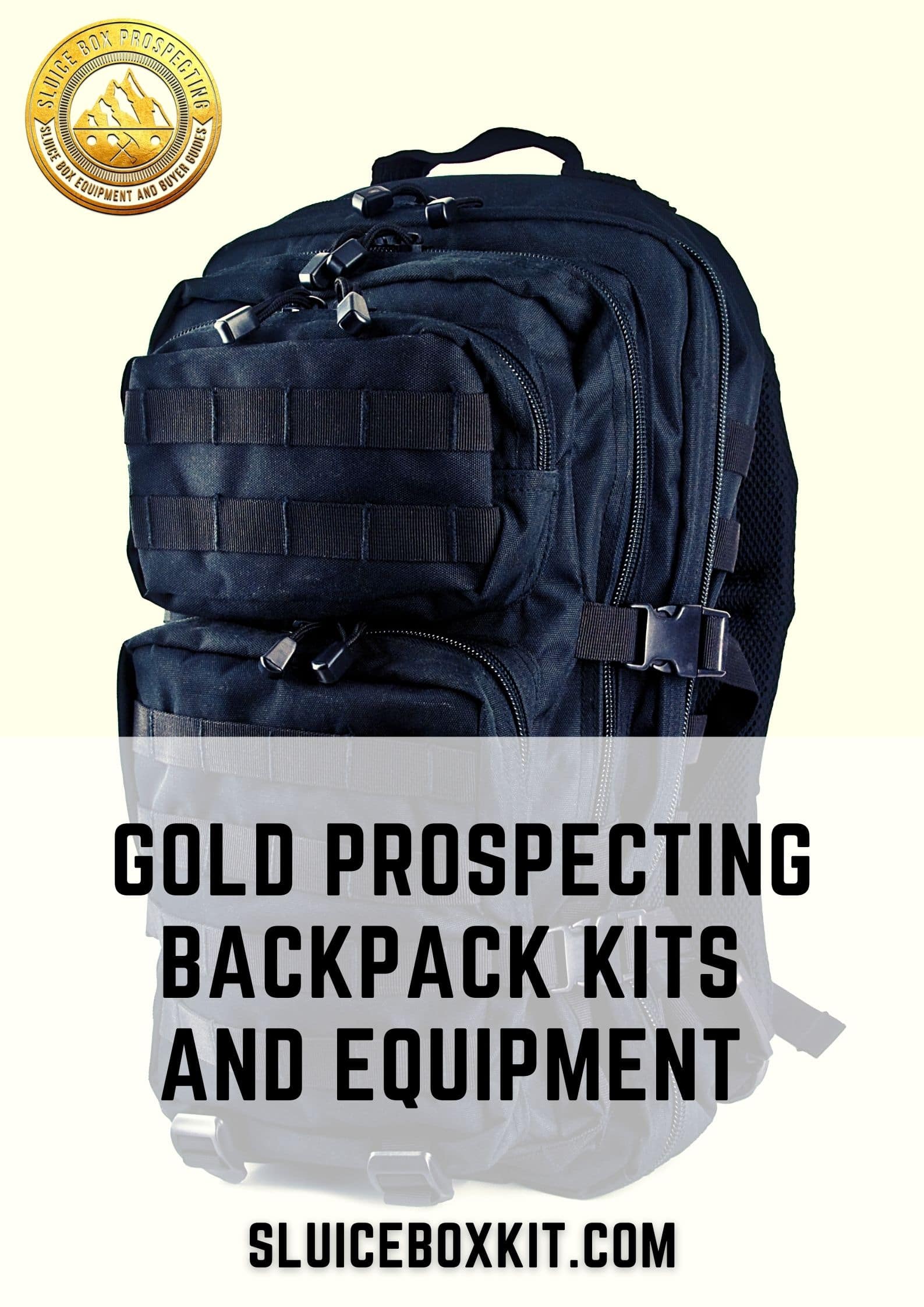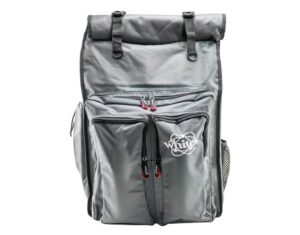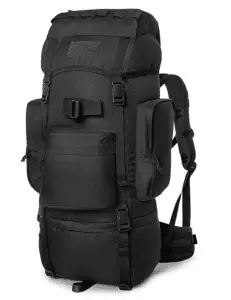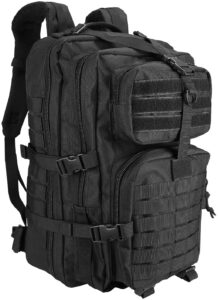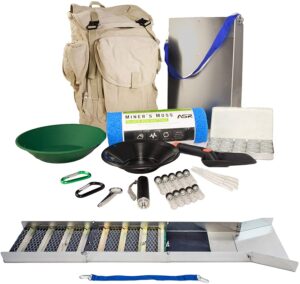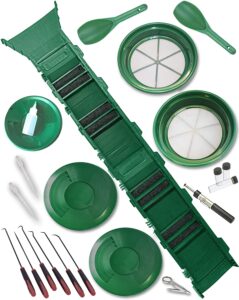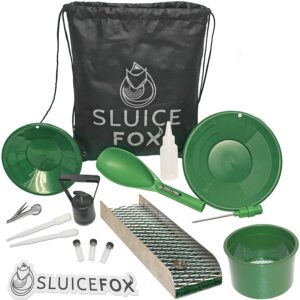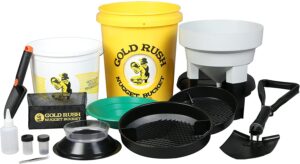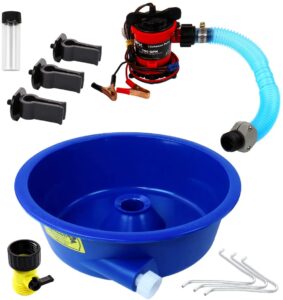When it comes to prospecting, a prospector is only as good as their backpack. A prospecting backpack is necessary for carrying all the tools necessary to pan for gold. It also offers storage for the kind of backcountry hiking necessary to get to some of the best prospecting spots.
The best prospecting backpack is the ALICE backpack, also known as an All-Purpose Lightweight Individual Carrying Equipment. ALICE backpacks were originally designed for military use but have found new purpose as backpacks suitable for carrying around heavy prospecting gear.
While ALICE backpacks are acknowledged by many prospectors as one of the best choices for hauling prospecting gear, there are some other good options for prospecting backpacks available on the market. Read on to learn more about ALICE backpacks and why they’re a good option for prospecting.
Gold Prospecting Backpack Kits & Equipment Guide
Table of Contents
ALICE Backpacks Are Perfect for Prospecting
There are many different kinds of backpacks that are commonly used for prospecting, but one of the most popular types is the ALICE backpack. ALICE backpacks were designed in 1973 for use in the American military, but they were eventually phased out. These backpacks are still very popular with prospectors, campers, and survivalists.
ALICE backpacks have two major systems:
- Belts: ALICE backpacks are held together with a series of adjustable straps that make it easy to add extra storage or attach accessories.
- Bag: The bag part of the ALICE backpack includes the bag, the cover, and the frame. The frame of the pack is used to help balance the load, which makes it easier for prospectors to pack in heavy equipment without extra fatigue.
ALICE backpacks are designed to be as lightweight as possible so that soldiers could preserve as much energy as possible for combat. This means that they’re also a good choice for prospectors since prospectors have to carry prospecting equipment as well as their survival gear when they seek out remote prospecting locations.
A major advantage of using ALICE backpacks for prospecting is that since these backpacks are discontinued for official military use, they can be easily found in many army surplus stores for a relatively low price. These stores are also a good option to get some prospecting accessories to go with an ALICE backpack such as tin campfire cooking equipment or a canteen.
Advantages of an ALICE Backpack for Prospecting
ALICE backpacks are the best prospecting backpack for a few reasons, most of them to do with practicality. Here are the best reasons to choose an ALICE backpack for prospecting (Source: Military Pack Guide):
- Durability: ALICE backpacks are designed to be very sturdy and can endure years of use in harsh outdoor environments without requiring replacement. This durability is one of the reasons that ALICE backpacks are still commonly found in army surplus today in good enough shape to still use for prospecting. (Source: Gold Prospectors)
- Lightweight: ALICE backpacks are relatively light compared to some other camping backpacks or trail packs. This makes them a good option for any kind of prospecting where you have to hike a few miles in to get to a camping or prospecting spot.
- No zippers: Zippers can be easily damaged by heavy loads while backpacking to a prospecting location, and once a zipper is busted, it renders part of the backpack’s storage useless. Not being able to pack part of the backpack due to a broken zipper can also throw off the balance of the entire load. ALICE backpacks use straps with metal buckle adjustments instead of zippers.
- Large loads: ALICE backpacks are renowned for being able to carry large amounts of gear, so they’re perfect for carrying a wide range of prospecting accessories. You’ll never have to choose between tools if you don’t want to if you use an ALICE pack since you can carry both.
- Suspenders: Most ALICE backpacks come with a suspenders system that allows the prospector to add additional pouches, sheaths, or other equipment. These suspenders also help hold the ALICE pack’s belt in the correct position so that the load remains balanced.
Along with the design features that make ALICE packs a good choice for prospectors, the fact that these backpacks are easily found secondhand is another mark in their favor. This can help the prospector save the bulk of their prospecting budget for tools and equipment.
Disadvantages of an ALICE Backpack for Prospecting
ALICE backpacks may have a lot of advantages that make them the best prospecting backpack choice, but there are some disadvantages to these packs too. Here are some of the less popular features of the ALICE backpack (Source: Trail and Summit):
- Not comfortable: The sturdy materials that the ALICE pack is constructed of are not particularly comfortable. Even though the lightweight design means that the pack isn’t especially heavy even when loaded down, these packs aren’t built with any kind of cushioning to protect the wearer from chafed shoulders or a sore back.
- Not good for backpacking or thru-hiking: This won’t be a deciding factor for some prospectors, but the ALICE backpack isn’t a good choice as a multi-purpose pack for both prospecting and backpacking. This is because it isn’t built with any ergonomic features.
- No easy access: The metal buckle and strap system of ALICE backpacks means that it isn’t quick access to anything that is stored away inside the pack. Prospectors who have any tools or items that they want quick access to do have the option to clip on additional quick-access storage pouches, however.
- Not waterproof: Even though ALICE backpacks are moisture-resistant, these bags are not waterproof, and anything inside that isn’t in a waterproof container (such as fire starting material) can eventually become wet.
No prospecting backpack is perfect, and the ALICE pack does have a few drawbacks. The fact that the pros far outweigh the cons means that the ALICE backpack is still the best prospecting backpack available for most prospectors.
Alice BackPacks For Prospecting
Product Dimensions:
21 x 16 x 4
Made of Rugged Water-Resistant Ballistic Nylon Fabric with Chest Strap for Weight Distribution, Top Quality Zippers, and Pulls, Padded Straps and Back Panel.
Product Dimensions:
50L : 11.4 x 9.1 x 28.3, 3.9 lbs
60L : 13 x 9.4 x 29.9, 4.5 lbs
Modular lightweight load-carrying equipment all around the pack. Also includes an extension collar with two drawstrings on the top. The backpack can expand to increase the main compartment capacity by 5 liters.
Product Dimensions:
18 x 13.2 x 11.6
The backpack is built with double-stitched seams, heavy-duty zippers, breathable mesh, padded backing, and a functional compression system for space-saving; Consideration on every detail, ideal for gold prospecting activities.
Prospecting Backpack Kits
Even the best prospecting backpack on the market isn’t much use without the supplies to fill it up. This is where prospecting backpack kits come in. These kits are a great way for prospectors to get the full gamut of tools and equipment they’ll need to go prospecting.
Here are a few of the best prospecting backpack kits on the market to go with your prospecting backpack:
ASR is a prospecting kit that comes with a canvas backpack, making it a one-stop-shop for your prospecting supply needs. This panning supply kit comes with a sluice box along with pipettes, a magnifying tweezer, sifting pans, glass vials, a flashlight, and a trowel.
Sluice Box features plastic equipment designed with a dark forest green color that makes gold flakes stand out more clearly while panning. The kit also includes stackable sifting pans that fit easily over a five-gallon bucket. There’s also a handpick for prospecting in bedrock cracks.
This gold panning kit is a smaller version of Sluice Fox’s standard gold panning kit. The sluice box for the standard panning kit is fifty-three inches, but the miniature version features a twelve-inch “pocket” sluice box instead. This makes the mini kit a good option for those prospectors who are trying to keep their gear as lightweight as possible.
The Gold Rush Nugget Bucket was featured on the television show Shark Tank and features everything you could need for prospecting in a lightweight seven-pound stackable kit. The concentrator bowl on this kit also helps prospectors catch smaller flakes of gold as well as larger pieces.
This bright blue concentrator kit is perfect for separating gold micro-fines from other particulates. This prospecting kit is specifically designed for gathering the smallest amounts of gold detectable, and the tools included take a lot of the tedium out of panning fine gold. The Blue Bowl Concentrator Kit is capable of picking up powder-fine gold.
Any prospecting kit you get to go with your backpack should include:
- A sluice box
- Sifting pans
- Vials
Accessories to help you visually search your pans, such as loupes or magnifying glasses, are also helpful.
The supplies needed for prospecting can also be bought as individual pieces, so if you find a prospecting kit you like but it doesn’t include a tool you want, this can always be added to your prospecting kit later on if you get a multi-purpose pack like an ALICE backpack.
What to Look for in a Prospecting Backpack
If you’re in the market for a prospecting backpack, there are certain qualities you’ll want to be on the watch for while you’re comparison shopping. Some of these traits in a prospecting bag may be more important to you than others—it all depends on your individual style when it comes to prospecting.
Here are a few things to look for when you’re shopping for prospecting backpacks:
- Price: If you’re going to be doing a lot of backpacking or thru-packing along with your prospecting, you may be better served to spend a little extra money to have a pack custom-fit to your body. But if you’re prospecting alone, a secondhand ALICE backpack from the Army surplus store can serve just as well at less than half the cost.
- Storage: Prospecting backpacks with several pockets in multiple sizes can make it easier to keep smaller prospecting tools such as vials, tweezers, and magnifying lenses more organized and easier to access. Prospecting backpacks should offer multiple ways for prospectors to organize and pack their gear, so the load is easy to balance.
- Durability: Whether you go prospecting twice a year or twice a week, you’ll want to look for durable materials in your prospecting backpack. This is especially true when it comes to fasteners, such as clasps and buckles.
- Size: Keep in mind that smaller backpacks may be more lightweight, but they’re not a good option if you have a lot of gear you want to pack or a larger sluice box. You might need a larger pack if you’re planning on including some packing equipment along with your prospecting gear for overnight prospecting trips.
- Fasteners: Check the customer reviews on the backpacks you’re considering to see how well the fasteners such as clasps, carabiners, and buckles hold up over time. Some backpack fasteners are made out of cheap materials that may break quickly. Zippers are usually not a good idea for fasteners on prospecting backpacks because they are easy to break under heavier loads.
Keep in mind that additional straps can be added to the backpack’s belt system to add auxiliary storage in the form of pouches or carabiner straps. This lets you hang additional gear off the pack at some expense to your backpack’s overall balance. Once you become practiced at loading out a prospecting backpack, you should get a good feel for how much gear you can comfortably bear.
Where to Get Prospecting Backpacks
Along with the Army surplus stores mentioned earlier in this article, there are also other sources for a good selection of prospecting backpacks. Here are some of the different places you can try looking for the best prospecting backpacks:
- Flea markets: Like Army surplus stores, flea markets can be a great place to find a good backpack for a discounted price. Because the bags are meant to last, you can often find them in very good condition for sale used. A flea market is also a good place to pick up other potential prospecting gear, such as metal detectors.
- Large online markets: Large general online markets such as eBay or Amazon are a good option for shopping when it comes to hunting for a good prospecting bag. These markets offer niche selections that may not be available in brick-and-mortar stores. They often offer a variety of related accessories, too.
- Specialty markets: Along with the large general online markets, there are also markets geared towards prospecting and backpacking gear such as Survival Frog that can give you a good selection of prospecting backpacks to choose from. These specialty websites may be a bit more expensive, but they also offer brands that aren’t readily available elsewhere.
Prospecting backpacks are available through plenty of vendors, so you should have more than enough to choose from. You’ll be looking for gold and gems before you know it!
Tips for Loading a Prospecting Backpack
To get the most out of your prospecting backpack, you need to be sure to pack all of the tools that you need without overloading your pack. Luckily prospecting equipment shops offer tools that are miniaturized to fit comfortably in a prospecting backpack.
Loading your prospecting backpack efficiently comes down to more than just choosing the right backpack for the job. Follow the tips below to get the most out of your prospecting kit.
Choose a Pack That Can Carry a Five Gallon Bucket
A five-gallon bucket is one of the most useful tools that a prospector can bring along. Along with aiding in sifting activities, a gallon bucket is useful for being able to carry other tools inside of it to maximize storage space inside the prospecting backpack.
Remember to Pack Light
Don’t worry about bringing duplicate tools or overpacking your prospecting backpack to include every last accessory, especially if you’re planning on hiking out with your prospecting bag to a remote location. ALICE backpacks and other common prospecting backpacks are not very comfortable packs for long-hauling equipment, and you’re likely to arrive at your prospecting site sore if you carry too much.
The More Pockets, the Better
Having plenty of pockets is a good idea in a prospecting backpack, and it also allows you to keep your hiking and survival gear separate from your prospecting gear. Keeping electronic equipment such as your cellphone in an innermost pocket is a good idea to help prevent it from getting wet when you go prospecting by a river.
Pack the Bag Heavy on the Bottom
If you pack heavy or bulky items near the top of your backpack, this will cause the balance of the backpack to be off. To compensate, your body will have to shift weight more frequently, and you will end up more fatigued. Keep your heaviest items in the bottom of the pack and pack lighter items on top. This will help to keep your back straight. (Source: REI)
Choosing a good backpack can go a long way towards making your prospecting hike an easier experience. Knowing how to best pack the bag can make a prospecting bag less difficult to handle too.
Prospecting Backpacks Are Great for Gold Panning
Whether you’re a veteran prospector or you’re just now looking into panning for gold for the first time, a good prospecting backpack can be the perfect catch-all for all the tools you’ll need. Choosing a sturdy pack with plenty of storage can make a big difference in how long your prospecting backpack lasts before you’ll need to replace it.

